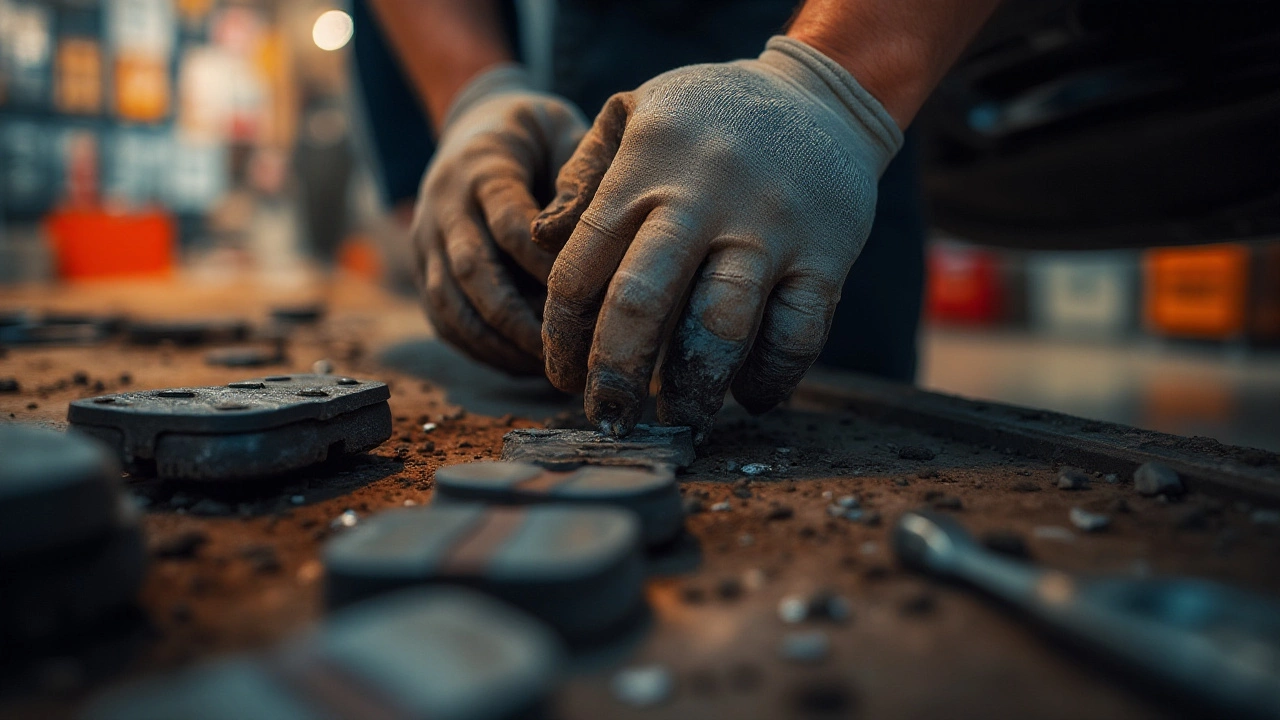 Jan, 31 2025
Jan, 31 2025
Brake pads aren't the most glamorous component of your vehicle, but they play a crucial role in keeping you safe on the road. Understanding the signs that indicate a need for replacement can prevent serious accidents and save you from unexpected costs. Brake pads wear out over time due to friction, and recognizing the signals they give you can mean the difference between a smooth stop and a risky delay.
One of the most obvious signs is a distinct squealing or screeching noise whenever you engage the brakes. This sound typically comes from a small metal shim, called an indicator, which alerts you when the pads are nearing their end. It's like a tiny alarm bell that shouldn't be ignored. In addition to auditory warnings, you might feel vibrations through the pedal or experience increased stopping distances, indicating the need for a closer look.
Regular checks under the hood can also reveal the condition of your pads. If they're less than a quarter inch thick, it's time for a change. Coupled with responsible driving habits, maintaining your brake pads ensures a smoother, safer ride. Remember, when in doubt, professional advice is always a wise choice, as experts can accurately assess wear levels and keep your braking system in top condition.
- Signs Your Brake Pads Need Attention
- Understanding Brake Pad Lifespan
- Performing a Visual Check
- Getting Professional Maintenance
Signs Your Brake Pads Need Attention
Driving with worn-out brake pads can compromise safety significantly. One of the first telltale signs is an unusual sound every time you hit the brakes. A persistent squeaking or screeching noise could be your car's way of alerting you that your brake pads have reached their wear limit. These noises often result from the exposure of the wear indicator, a small metallic piece that rubs against the brake rotor to produce an audible warning. Ignoring this noise can lead to more severe— and more expensive—issues, possibly damaging the rotors themselves.
Another sign that shouldn't be ignored is a pulsing or vibrating brake pedal. This sensation often points to warped rotors, a side effect of extended use of worn-out pads. If you feel the vibrations during normal braking, it is high time to check the state of your rotors and pads. These vibrations can significantly impact your vehicle's stopping power, demanding an immediate assessment to ensure safe driving conditions. Regular checks for brake responsiveness can help catch these early, avoiding serious mishaps.
A harder-to-spot warning is the gradual reduction in braking performance. If it seems as though you're needing to press harder than usual or your stopping distance increases, the problem might be linked to your brake pads. Brake fade can occur because of constant friction and heat buildup, which undermines the effectiveness of your braking system. It's crucial to recognize these subtle shifts in performance to avoid endangering yourself and others on the road.
An effective, albeit hands-on, approach is a visual inspection. You can peek through the spaces in your wheel to see the thick layer of your pads. Less than a quarter inch thickness can indicate that it's time for a replacement. If there are visible cracks or excessive dust on the pads, these are also signs that they are past their prime. If you're not confident doing this yourself, a visit to a trusted mechanic is a sound strategy.
According to the National Highway Traffic Safety Administration (NHTSA), keeping your vehicle's braking system in peak condition directly correlates to safer driving experiences and minimized collision risks.Being aware of the brake maintenance signs can steer you toward a proactive approach to car care. Neglecting these signs invites not just repair costs but potential accidents as well. Ensuring timely replacement of your brake pads helps maintain not only vehicle health but also essential safety, offering peace of mind whenever you hit the road.
Understanding Brake Pad Lifespan
The lifespan of brake pads is a topic that many drivers find themselves curious about at one point or another. It’s a crucial aspect of brake maintenance, yet it varies widely depending on several factors, each playing a significant role in how long they’ll last. Typically, brake pads are expected to last anywhere between 25,000 to 70,000 miles. This wide range is influenced by the type of vehicle you drive, your driving style, and the kind of brake pad material you're using. For example, aggressive driving habits, such as frequent hard braking or high-speed stops, can significantly reduce your brake pad’s lifespan. Similarly, constantly driving in stop-and-go city traffic can wear them down faster compared to highway driving.
Your vehicle maintenance schedule and the material of your brake pads also matter a lot. Ceramic brake pads, known for their durability and low brake dust production, often last longer than their semi-metallic or organic counterparts. Semi-metallic are great for performance but tend to wear out quicker. On the other hand, organic pads, made from materials like glass or rubber, are often softer and can wear down faster. Regularly checking the condition of your brake pads when you perform other routine maintenance tasks can give you a better understanding of when they need to be replaced.
Proper knowledge of your specific vehicle model and manufacturer recommendations also play a part. Some cars, especially luxury models, may use sensors that can alert you to pad wear. Aligning regular inspections with these alerts can maximize both safety and pad life. According to the National Safety Council, ensuring that your brake pads are in top shape is essential for safe stopping and should never be overlooked.
A seasoned auto mechanic once remarked, "Taking care of your brake pads is like taking care of your shoes—look after them well, and they will take care of you when you need them most."
Moreover, environmental conditions like heavy rain, snow, or urban areas with sandy roads can accelerate wear. By driving responsibly, adapting to conditions, and being mindful of your driving environment, you can significantly extend the life of your brake pads. Understanding these aspects provides peace of mind, knowing that your car’s primary safety system is functioning as it should. By educating yourself on these variables, you’re not just practicing good vehicular habits — you are securing your safety, saving on future repair costs, and ensuring your daily journeys are smooth and uneventful.

Performing a Visual Check
Conducting a visual inspection of your brake pads is a straightforward yet essential part of car maintenance. With the right know-how, you can quickly assess whether it's time for a replacement. Start by checking the pad thickness. Standard new brake pads are typically between 10 to 12 millimeters thick. The minimum recommended thickness before considering a change is about 3 millimeters. If you can see that the pads are nearing this limit, it’s time to think about replacements.
To perform a visual check, first ensure your vehicle is safely parked on a flat surface with the handbrake engaged. Remove the wheel to expose the brake caliper and the pad itself. Being able to do this yourself not only saves money but also gives you confidence in the condition of one of your car’s most crucial safety features. Look for uneven wear, as one side of the pad might wear down more quickly than the other. This can be a sign of caliper problems or rotor issues that might require professional attention.
A visual inspection isn’t only about thickness. Note the color of the rotor and pads. Unusual discoloration, like a glazed or shiny appearance, can suggest overheating or a need for immediate service. Remember, brakes are subjected to intense pressure and temperature, and visual cues like cracks or chips can be early indicators of significant issues. Sometimes, inspecting the pads might reveal grooves or deep lines, indicating rotor damage that needs addressing.
Tools and Safety Precautions
Before starting, gather the necessary tools, including a jack, a lug wrench, and a flashlight for clearer visibility. Wearing gloves can protect your hands from dust and debris. It’s recommended to work in a well-ventilated area, especially if you're disassembling parts. Be cautious with all the components they are attached solidly. Never compromise on safety when handling brakes."Visual inspections can prevent minor issues from escalating into expensive repairs," says Jason C. Ford, a certified automotive technician. "Early detection is key, and a simple look can spare you from future headaches."
Regularly inspecting your brake pads should be as routine as checking tire pressure or oil levels. By incorporating these visual checks into your maintenance schedule, you'll extend the life of your vehicle while ensuring your safety on the road. Detailed attention allows car owners to tackle small fixes before they become critical safety concerns.
Getting Professional Maintenance
There's an undeniable peace of mind that comes with allowing a professional to inspect your brake pads. With trained eyes and experienced hands, a mechanic can catch issues that might slip past the average car owner. Regular professional maintenance not only involves changing brake pads but also a comprehensive check of the entire brake system, including rotors, calipers, and the braking fluid. During a maintenance visit, a technician can properly gauge the wear level and suggest the right type of brake pads tailored to your car model and driving habits.
One compelling reason to seek professional help is the access to advanced diagnostic tools that professionals use. These tools offer insights that go beyond a visual inspection, picking up subtle signs of issues such as uneven wear or potential hydraulic problems. By trusting a mechanic, you're benefiting from their wealth of experience and specialized tools, which ultimately saves you time and potential frustration down the road. It's the difference between a quick fix and a thorough solution.
Professionals often provide a comprehensive report after inspection. This report includes potential problems that could arise if parts go unattended, making it an essential part in planning vehicle maintenance. For instance, regular maintenance checks can help avoid the risk of brake pad glazing, which occurs when there's excessive heat, causing the pads to lose effectiveness. This little-known issue can be identified early by skilled hands, preventing accidents that stem from suddenly reduced braking capacity.
"The biggest advantage of professional brake service is their ability to foresee what you might not. It's predictive, preventive, and it saves more than it costs in the long run," notes James Goodson, a well-regarded automotive expert.One cannot emphasize enough the value of developing a rapport with a trusted mechanic. With regular visits, they'll understand your vehicle's peculiarities and offer personalized advice, guaranteeing not just performance but also longevity of your brake system.
Comparing brake service costs and fees may reveal that a routine professional check is not as pricey as assumed. In fact, the long-term savings overshadow the upfront costs, especially when factoring in expenses from potential emergency repairs. Shops frequently offer service packages that not only address the brake maintenance needs but also check other critical systems like alignment and suspension. These packages are designed to be cost-effective, keeping your vehicle in pristine condition without breaking the bank. Having a vehicle breakdown is no one’s idea of a good time, and proactive brake maintenance can be the key to staying safe and confident on the road.